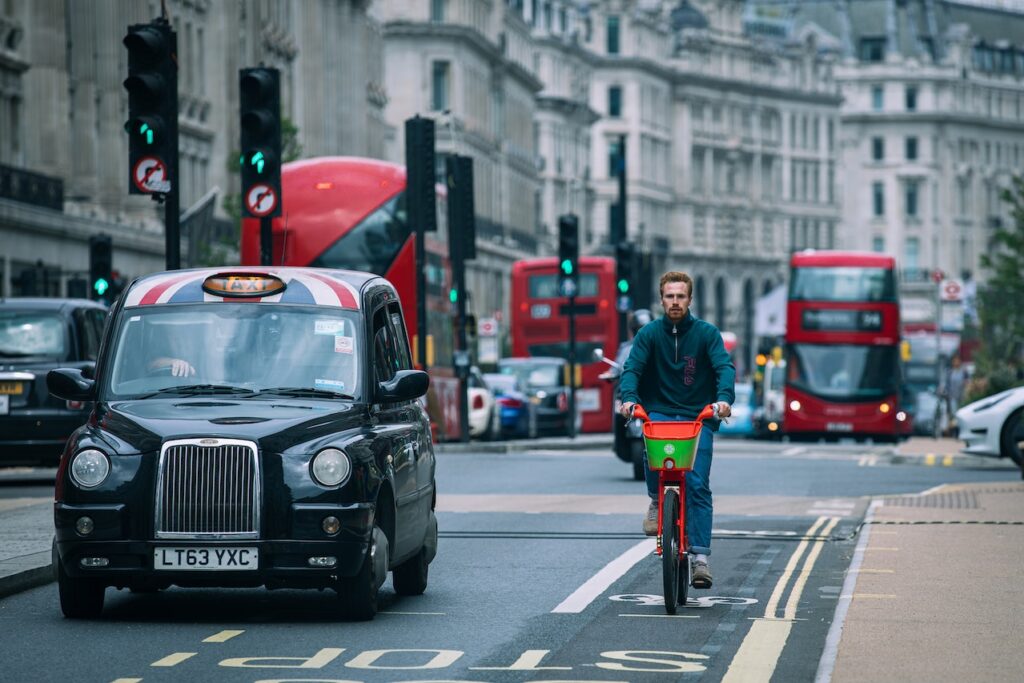Cycling in London has become increasingly popular as people look to save money on public transport, reduce their carbon footprint, and enjoy the health benefits of cycling. However, the question remains: is it safe to cycle in London?
Is it safe to cycle in London? The State of Cycling in London
Cycle Lanes
A big factor in determining cycling safety in London is the availability and quality of cycle lanes. Over the past few years, significant investments have been made to develop “Cycling Superhighways,” providing safe and segregated cycling networks across the city. These cycle lanes offer a safer environment for cyclists, as they are separated from motorised traffic and, in some cases, pedestrians.
However, not all areas of London have adequate cycle lanes. In some parts of the city, cyclists still share the road with cars, buses, and lorries, which is a far from ideal situation.

Side Streets
Side streets can provide a safer alternative to busy main roads for cyclists. These quieter routes often have less traffic and lower speed limits, reducing the risk of accidents.
However, navigating side streets can sometimes be confusing and require extra attention, as they may not always have clear signage or dedicated cycle lanes. It’s sensible to plan your route ahead of time, identifying the quieter side streets that will make your journey safer and more enjoyable.
Road Users
Cyclists in London share the roads with other types of road users, including cars, buses, lorries, motorcycles, and pedestrians. To ensure your safety (and theirs), you must be aware of the different road users you may encounter and how they may respond to your presence.
For example, lorries and buses have significant blind spots, making it difficult for drivers to see cyclists. Riding in a lorry’s blind spot can be extremely dangerous, so it’s essential to give these vehicles plenty of space and be cautious when overtaking them.
Segregated Cycling
Segregated cycling lanes are physically separated from motorised traffic, providing a safer space for cyclists.
Segregated lanes have been shown to increase cycling participation and improve safety for all road users.
However, only six per cent of the existing cycle lane length in London is segregated from traffic.
Cycling Safety Tips
To ensure your safety while cycling in London, consider the following tips:
- Wear a helmet: Wearing a helmet can significantly reduce the risk of head injuries in the event of a cycling accident. Make sure your helmet fits correctly and is securely fastened.
- Be visible: Wear bright clothing. Always use the lights on your bike when the weather or time of day dictates. Being visible to other road users reduces the likelihood of accidents.
- Signal correctly: When turning or changing lanes, use clear hand signals to communicate your intentions to other road users.
- Maintain a safe distance from lorries: Give large vehicles plenty of room – if you can’t see their mirrors, then they can’t see you! If you can’t see their mirrors, then they can’t see you!
- Beware the parked car: Keep an eye on them as you approach to pass in case they set off again without signalling or alternatively open their door into your path. Watch out, too, for pedestrians or other cyclists when riding near parked cars.
- Don’t get into a situation where you haven’t got a safe exit: don’t get boxed in or try to tailgate vehicles.
- Stay focused and make eye contact: Pay attention to your surroundings, and try to make eye contact with drivers, especially at junctions and crossings, to ensure they have seen you.
- Remain calm: Road rage is unproductive and can lead to dangerous situations. Stay calm and courteous, even when faced with aggressive behaviour from other road users.
- Know the route you’re going to take: It might seem an obvious thing to say, but it’s important, from a safety point of view, to know the route you are going to take before you set off. Choose the safest route, too, making use of cycle lanes and side streets whenever possible.
- Don’t gamble on amber: It’s never a great idea togo through traffic lights that are in the process of changing against you, and particularly so in London.
Traffic-Free Cycle Routes in London
Several traffic-free cycle routes in London offer a safer cycling experience. Some of these routes include:
- Olympic Park
- Epping Forest
- Hampstead Heath
- Regent’s Park
- Greenwich Park to Gravesend
- Richmond Park
These routes are typically free from motorised traffic, providing a more peaceful and enjoyable cycling experience.
Cycling in London and Public Transport
Cycling in London can be combined with public transport to make your commute more manageable. Folded bikes are allowed on public transport anytime, whereas non-folded bikes have specific restrictions, particularly during peak hours. Ensure you familiarise yourself with the rules regarding bikes on public transport to avoid any issues.
The Best Cycle Routes in London
London has many fantastic cycle routes for both commuting and leisure. Some of the best routes include:
- King’s Cross to Notting Hill
A 10km ride alongside Regent’s Canal, cycling though and near to Camden Lock, Regent’s Park, Little Venice, and finishing in the vibrant neighbourhood of Notting Hill.
- Finsbury Park to Alexandra Palace
A flat 6km route that follows an old disused railway, offering peaceful, leafy paths and incorporates a stunning view from Alexandra Palace.
- Limehouse Basin to London Fields
This route will take you on a lovely six kilometre ride along a quiet part of Regent’s Canal, passing through Mile End Park, Victoria Park, and London Fields.
- The Tower of London to Big Ben
A 5km ride along the river, featuring world famous sights like the Tower of London, The Shard, Tate Modern, Shakespeare’s Globe Theatre, London Eye, and Big Ben.
- Battersea to Kew Gardens
This route starts at Big Ben and heads west, passing the Tate Britain, Battersea Power Station, Fulham Palace, and ending at Kew Gardens.
Cycling Accident Statistics and Personal Injury Claims in London
According to the 2022 Global Bicycle Cities Index, London ranked 62nd globally for cycling safety. The report highlighted that there were 0.68 fatalities per 100,000 cyclists and 1,299 accidents per 100,000 cyclists in London.
It’s essential you aren’t blasé about the risks. Instead, be aware of them, and take necessary precautions, some of which we have highlighted above. The overwhelming majority of cyclists who take trips around London on bicycles every day do so without suffering any mishap or injury.
If you are involved in a cycling accident in London that was not your fault, you may be eligible to make a personal injury claim. Gathering as much evidence as possible, including photographs of the accident scene and getting witness details, is vital to support your cycling accident claim. Consulting with a specialist personal injury solicitor at Mooneerams is the best way to ensure you receive the compensation you deserve.
Final Thoughts on Cycling Safety in London
Cycling in London can be safe and enjoyable if you take the necessary precautions and plan your route carefully. Use cycle lanes, side streets, and traffic-free routes to minimise your risk of accidents. Stay vigilant, wear appropriate safety gear, and follow the rules of the road to ensure a safe and pleasant cycling experience in the city.

